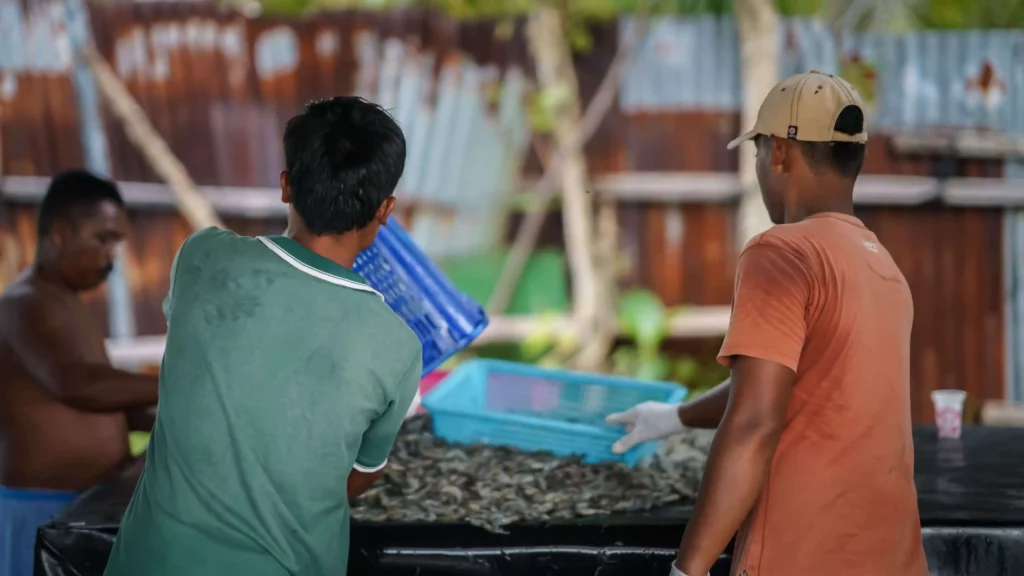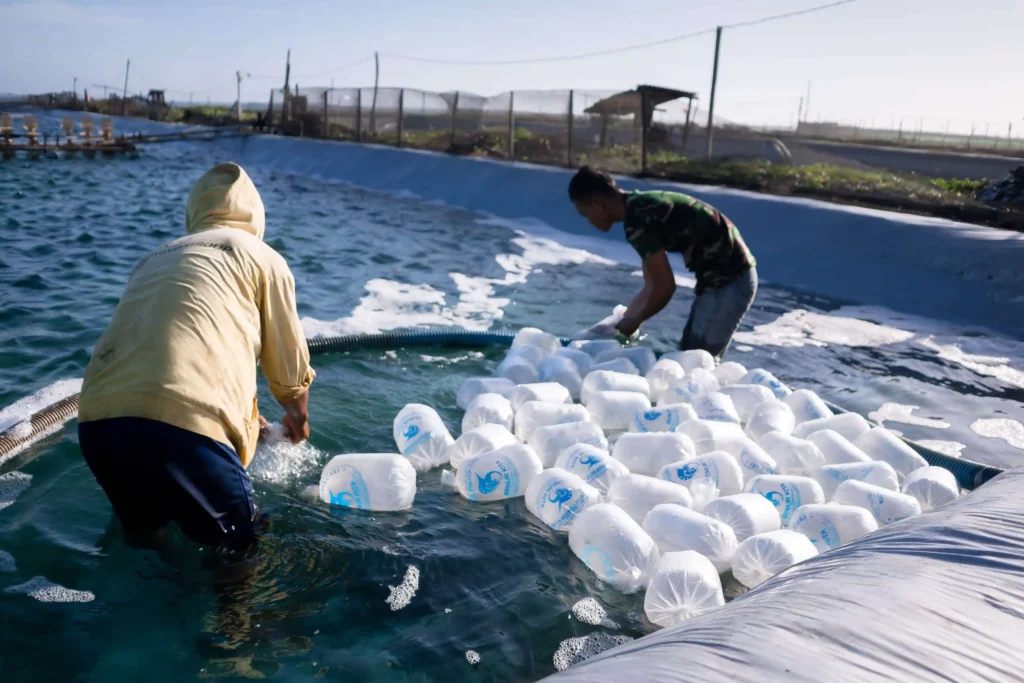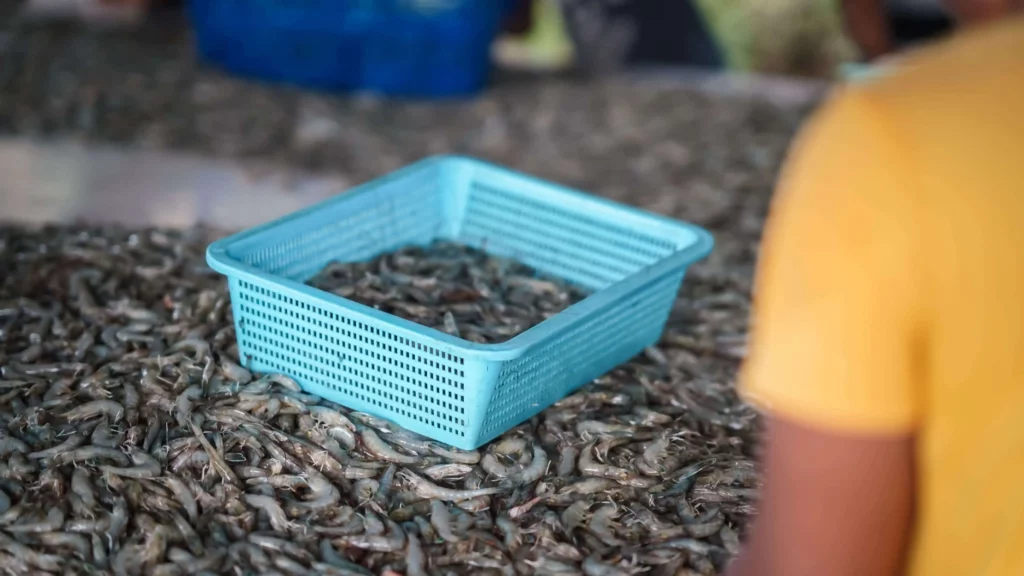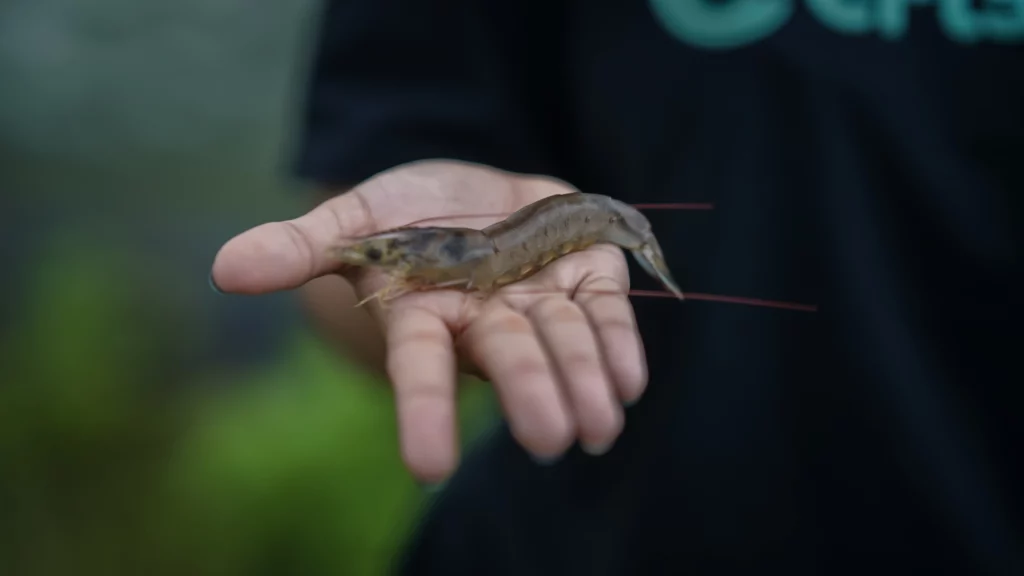Artikel Ini Telah Direview Oleh:

Eko Afriantoro
Praktisi Budidaya Udang
How to increase shrimp SR is quite easy. In general, you only need to pay attention to important factors in cultivation, such as maintaining water quality and feed quality.
However, in practice it was quite difficult to prevent a decrease in shrimp SR. What are the causes of decreased SR levels, and what are the solutions? Come on, find the answer in this article.
Survival Rate (SR) in Shrimp
Survival, or survival rates (SR), is a parameter to determine the survival success of the shrimp stocked in 1 cultivation cycle and is expressed in units of percent.
The ideal SR number ranges from 80-90%. However, what is happening now is the difficulty of getting the ideal number. On average, the SR level is quite low, ranging from 70-80%, even in certain types of shrimp the SR level is much lower, namely between 33-42%. The low SR number is based on the ability of the farmer to raise shrimp during 1 cultivation cycle.
In fact, to achieve success when cultivating shrimp, farmers need to pay attention to shrimp growth and survival rates or survival rates (SR) because these two factors will affect the tonnage of biomass which determines whether cultivation produces maximum yields.
Several factors affect the high and low SR of shrimp, including water quality, salinity system, ammonia content, amount of plankton, use of quality fry, feed management, space for movement, moulting, to the weather.
Causes of Low SR

Actually, what affects the survival rate is how you behave and how you handle it when raising shrimp. For example, carelessness when taking shrimp samples, not maintaining water quality, pond salinity, not using the right fry, minimal space for movement, feed management, the moulting process, to broad factors such as weather and pests.
1. Water Quality is Decreasing
The first factor affecting the decrease in SR level is the decrease in pond water quality. Water quality includes water temperature, acid-base level (water pH), dissolved oxygen, and water brightness.
- Water Temperature
Water temperature plays an important role in shrimp farming because it directly affects shrimp behavior, shrimp growth, reproduction, molting, molting, immunity, survival and metabolism of shrimp. The ideal temperature for shrimp ponds ranges from 26-32 degrees Celsius. If the temperature is below 14 degrees Celsius, the shrimp has the potential to die quickly, the temperature is below 20 degrees Celsius, the shrimp's appetite decreases, the temperature is below 25 degrees Celsius, the ability of the shrimp to digest feed is problematic. However, if the temperature exceeds 32 degrees Celsius it can cause stress-prone shrimp.
- Water pH
Tinggi rendahnya pH air dipengaruhi fluktuasi senyawa yang bersifat asam maupun fluktuasi O2 dan CO2. pH air yang sesuai untuk tambak udang berkisar antara 6-9. Bapak/Ibu dapat memeriksanya di subuh atau pagi hari. Apabila pH air mencapai lebih dari 10, maka udang lebih mudah mati, namun bila pH air di bawah 5 maka dapat menyebabkan nafsu makan udang menurun, udang jadi keropos dan berlumut, udang juga akan cepat lemah dan sakit, bahkan mati.
- Dissolved Oxygen (DO) Levels
Dissolved oxygen (DO) levels in shrimp pond water have a quite crucial role in determining the life and death of shrimp, including the shrimp growth process. Ideally the number of dissolved oxygen for shrimp ranges from 3-6 ppm.
- Water Brightness
The brightness of the water is the most underestimated factor. Though whether the water is bright or not can affect the activity of biota in the water. In other words, if the brightness of the water decreases, the survival of the shrimp in the pond will be affected.
2. Low Water Salinity
The ideal salinity or salt content for shrimp pond water ranges from 15-30 ppt. Especially for the age of 1-2 months, shrimp need a salinity level between 15-25 ppt so that the growth process is more optimal. As for the vaname shrimp specifically, the salinity figure is wider, which ranges from 0.5-40 ppt.
Salinity can affect the osmotic pressure in the cells of organisms so that if there is a very drastic change and exceeds the tolerance limit, the impact will be the death of the organism itself. Usually, the growth of shrimp will take place quickly if the pond water salinity is around 5-10 ppt, but at that rate the shrimp actually become more sensitive to disease.
The problem of salinity that is common today is the location of the shrimp ponds which are far from the sea, so you have to replace seawater with water sourced from drilled wells. In fact, the water salinity in the drilled well is relatively low. When the salinity rate is low, the shrimp growth process slows down, which also affects the decrease in the SR number.
3. Use of Benur

Choosing the best fry must be done by you so that the yield is more optimal. Some of them are ensuring that the fry are superior and have a good immune system.
Selain itu, memperhatikan ukuran benur yang akan dibesarkan juga penting. Idealnya benur yang dapat Bapak/Ibu tebar pada tambak udang minimal berukuran PL 10 dengan rata-rata panjang 8 mm.
4. Limited Shrimp Movement Space
The failure rate of cultivation when using fry that are too small will be further exacerbated when attention is paid to the environment and cultivation media for raising the fry.
For example in cage media where there are wild fish before the shrimp are stocked. Later, the fry will compete with these fish in the cages so that their space for movement is increasingly limited. When the space for movement is limited, shrimp are easily stressed and the immune system decreases. Not to mention when found pests or predators around the pond.
5. Shrimp Feed Management
The nutrients needed by shrimp include protein, carbohydrates, minerals, lipids, and vitamins. The ideal protein content for shrimp ranges from 30-55% from the total feed, while the need for phospholipids is only 2%, especially the phosphate content in the cholesterol pond, or phytosterols and highly unsaturated fatty acids (HUFA).
Considering that shrimp have cannibalism, when the quality and quantity of feed decreases, what happens is that the shrimp eat each other. This condition is not good for shrimp that are smaller than the others.
In addition, the imbalance of amino acids in the feed can also affect the shrimp during the moulting process. Because during the moulting process later, the shrimp will lose body protein around 50-80%.
6. Non-uniform Moulting Process
The moulting phase is a growth phase in shrimp which is marked by the replacement of the carapace or skin on the shrimp. When molting occurs, the body weight of the shrimp usually increases.
However, the problem that occurs is that during the molting phase the shrimp's immune system is weakened. Thus, when the molting process is not uniform, shrimp in the molting phase are more easily targeted by predators of fellow shrimp in the same cultivation medium.
7. Weather Affects Cultivation Time
The external factor that affects the decrease in shrimp SR is the weather. Indonesia has quite extreme weather characteristics so that farmers need to consider the best time to do shrimp farming.
For example, during the rainy season, rainfall can affect the increase in water temperature, water acid-base level, dissolved oxygen levels and pond salinity. The factors that affect the pH of water include rain and runoff, low levels of alkalinity, and the acidity of the soil and water sources.
How to Increase Shrimp SR

After knowing the factors that cause a decrease in shrimp SR, you need to know how to increase shrimp SR.
1. Water Quality Management
To ensure the quality of pond water, you must pay attention to 4 factors, including how to maintain water temperature, acid-base levels, dissolved oxygen, and water brightness.
Pond water temperature less than 25 degrees Celsius can cause a decrease in shrimp appetite. Then you need to be vigilant when the dry season arrives because during that season there will be an increase in temperature. To fix this, you can fill the pool with new water that has a lower temperature. In addition, reduce the amount of feed so as not to overfeeding.
Meanwhile, to maintain the pH of the water or acid-base level, you can use a lime system with lime doses ranging from 5-20 pm depending on the type of lime to be used.
Kemudian, untuk meningkatkan kadar oksigen terlarut (DO), sebaiknya Bapak/Ibu menggunakan kincir air agar suplai oksigen terlarut tercukupi. Adapun untuk menjaga kecerahan air, Bapak/Ibu dapat memanfaatkan bahan organik yang dapat melayang dalam air seperti plankton, jasad renik, detritus, atau bahan-bahan anorganik seperti lumpur dan pasir. Plankton dalam jumlah sedikit dapat membantu mencerahkan air tambak, sebaliknya plankton dalam jumlah banyak dapat memekatkan air tambak.
2. Increasing Salinity in Water
How to increase the SR of shrimp for the salinity system can be through two steps, namely the acclimatization system and the minerals. Especially for vannamei shrimp, these two steps have quite a significant impact on the shrimp SR number.
The acclimatization process is closely related to the stocking process. Benur originating from hatchery usually requires high salinity, namely 25-30 ppt. If the shrimp will live in ponds with a salinity of 5-10 ppt, then gradual acclimatization needs to be done.
The simulation is to make the pond salinity down to 30 ppt, then lower it slowly to 25 ppt, 20 ppt, until finally 5-10 ppt. It doesn't need to be directly in the cultivation medium, shrimp can adapt through a separate medium before finally being stocked. Gradual acclimatization is considered more efficient in keeping the shrimp from stress and avoiding mass mortality.
The second way is to pay attention to the balance of minerals, such as the minerals potassium (K), magnesium (Mg), and calcium (Ca). Even though you have confirmed that the salinity of ponds with water from wells is the same as seawater, the magnesium and potassium content is not necessarily the same. To overcome this, you can provide special products that contain the minerals needed by shrimp.
3. Uniform Benur Size Creates Unlimited Space
To create ideal space for movement, you are advised to use fry of the same size in 1 cultivation medium. Then pay attention to the stocking density of the fry in the pond, you need to consider the size of the fry and the stocking density in order to create more space for movement, avoiding competition that causes stress on the shrimp. Because when you are stressed, the immune system will weaken and this will affect the decrease in shrimp SR.
4. Suppress cannibalism through feed
To prevent cannibalism and preying on each other's shrimp, you must ensure that the quality and quantity of shrimp feed is met. To be sure, you can use anco. That way, you can find out how much feed is ideal for shrimp, especially when their appetite is high.
In addition, to overcome your own cannibalism, you can include tryptophan protein in the feed. Because tryptophan protein functions to reduce the aggressiveness of shrimp so that it can suppress its cannibalism.
5. Try a Uniform Moulting Phase
The non-uniformity of the moulting phase is one of the factors that causes shrimp to eat each other. Decreased immunity will occur in shrimp that are in the moulting phase. Therefore, it is best to try to make the moulting phase happen simultaneously by all the shrimp in the pond. However, what needs to be paid attention to is the importance of preparing feed in large quantities so that the mass moulting phase runs smoothly.
6. The Best Time for Shrimp Cultivation

To get the optimal SR number, one of the ways is by paying attention to the right time for shrimp farming. The best time for shrimp farming is also related to the weather.
Based on the results of direct research by farmers in the field conducted by one of the cultivation platforms, it is suggested to do shrimp farming in July. January and September are also the best times for shrimp farming because at the end of the cultivation process at that time it produces the best SR numbers.
Even though it has been guaranteed based on the experience of the farmers in the field, you still have to adjust to the conditions of your pond. Therefore, it is important to understand the condition of shrimp ponds.
7. Applying Special Probiotic Products
The last way to increase shrimp SR is to apply special probiotic products mixed in shrimp feed. For example, Aquatech's Protexin Probiotic product contains Bacillus subtilis-PXN21 which functions to increase growth and survival rates (SR).
By using this protexin probiotic, besides being able to increase SR it can also reduce mass mortality resulting from disease pathogen viruses and bacterial virulence, optimizing shrimp growth and health as well as feed efficiency.
Dapatkan Bantuan untuk Meningkatkan SR Udang bersama Ahli Budidaya!
Need Help Regarding Shrimp Cultivation Business?
Fill in your personal data in the following form. Our team will immediately contact you via the number cellphone attached. Make sure the data entered is correct.
SR udang merupakan salah satu penentu keberhasilan budidaya. Bapak/Ibu harus mengupayakan langkah-langkah pencegahan untuk menjaga SR udang tetap tinggi.
Jika Bapak/Ibu ingin langsung berkonsultasi dan mendapatkan rekomendasi terkait cara meningkatkan SR udang, Bapak/Ibu bisa langsung mengakses fitur Cultivation Consultation in app eFarm secara GRATIS. Bapak/Ibu akan berkonsultasi langsung dengan Ahli Budidaya eFishery dan mengetahui tips menarik lainnya seputar budidaya udang.
Fill out the form above to consult at Cultivation Consultation secara FREE!

Eko Afriantoro - Praktisi Budidaya Udang
Eko berpengalaman sebagai praktisi budidaya udang sejak tahun 2013 yang kini menjadi Farm Lead Research & Development (R&D) Shrimp eFishery.
Questions About How to Increase Shrimp SR
The causes of low shrimp SR are decreased water quality and salinity, the use of small fry, limited shrimp space, minimal shrimp feed regulation, non-uniform moulting phase, and weather that can affect the best time for shrimp farming.
The way to increase shrimp SR is to maintain water quality, increase pond water salinity, ensure uniform fry size, suppress cannibalism through shrimp feed management, try to synchronize the moulting phase, consider the best time for shrimp farming and apply the best probiotic products.
- https://agribiznetwork.com/kiat-tingkatkan-survival-rate-udang-windu/
- https://app.jala.tech/kabar_udang/budidaya-salinitas-rendah
- https://app.jala.tech/kabar_udang/kanibalisme-pada-udang
- https://app.jala.tech/kabar_udang/survival-rate-produktivitas-budidaya-udang?redirect=https%3A%2F%2Fapp.jala.tech%2Fkabar_udang%2Fperan-bakteri-budidaya-udang-vaname%3Fredirect%3Dhttps%253A%252F%252Fapp.jala.tech%252Fkabar_udang%252F44
- https://repository.polipangkep.ac.id/uploaded_files/temporary/DigitalCollection/ZDFmZmI1ZjJkNDU0OTU4M2Y5YjMwYzU3NDkyYzE5MmQ5NzEwNTk4OA==.pdf
